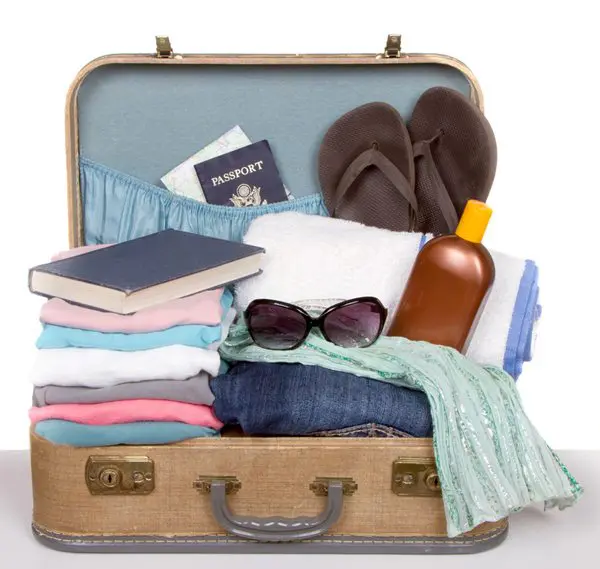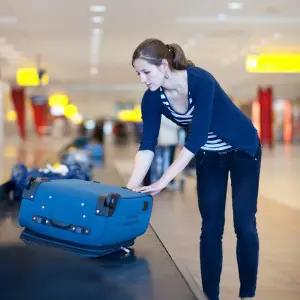Whether you plan to travel to an exotic destination, or whether you’re staying within national borders for a quick weekend trip, preparing your hand luggage is always a sensitive issue for travellers. These days, airlines seem to all have their own set of confusing rules about weight and size, and then to top it all off there are the liquid restrictions… To get you started on your trip with a lighter suitcase and a more relaxed mind, here are our tips and recommendations for preparing your luggage.

1 – Be well informed about airline baggage allowances: As every company, be it scheduled, charter, or low cost, has its own specifications when it comes to baggage allowances, you will need to check the specific rules before departure. Find a detailed version with baggage allowance by airline here. In general we can say that the weight of checked baggage is usually around 50 pounds, while the hand luggage should weigh between 22-26 pounds with the measurements 21.6 x 15.7 x 7.8 in (low cost) and 22 x 17.7 x 9.8 in (scheduled). For direct flights to the United States, generally the authorized checked baggage allowance is for 2 total bags weighing 50lbs each.
2 – Some airlines have special clauses: If you are travelling in business or first class, most likely there is an added allowance of 22 extra pounds. For frequent flyers who are members of the airline’s loyalty programme, they are usually entitled to 11, 22, or even 44 extra pounds depending on the number of miles they have earned. In the case of exceeding the weight allowance an extra fee will be charged so it is essential to prepare in advance.
3 – Optimise your baggage weight: For example, if you are staying at a hotel, consider that towels, shower gel, or a hair dryer are generally already included. For a backpacking trip, it’s better to bring light clothing that can be used both day and night. And if you’re going for long trip, every pound counts as the weight of your trip will be on your shoulders!
4 – For bulky or special items: It is essential to inquire at time of booking if you plan on travelling with any item that does not fit the standard baggage measurements. Depending on the airline, articles like wheelchairs, bicycles, push chairs are often subject to a special rate and they may or may not be included in your baggage allowance. The size of the item must be given to the airline beforehand and it will most likely also require special packaging.
5 – For other “special” or “particular” items: Musical instruments, like a cello or a double bass, are subject to a special rate, partly because the instrument often needs a seat (or more) to itself! Hunters and members of the military should know that guns are only accepted in the hold and not on all flights. Even if the airline allows firearms, you always have to submit a license and authorisation to transport.
6 – Transportation of liquids in hand luggage: Severe restrictions apply to all passengers departing from the European Union, Iceland, Norway, and Switzerland to any destination. Liquids, pastes, gels, and aerosols are allowed in the cabin if the volume of each container does not exceed 100 ml. Up to 10 bottles are allowed per passenger and must be enclosed in a transparent plastic bag that zips shut. All passengers, including children, can carry only 1 plastic bag each and it must be taken out of their hand luggage during the security scan.
7 – The exceptions: Baby food that is required during the flight is allowed as long as it is in packaging 100 ml or smaller. However, to bring the food on-board you will be required to taste each product. As for liquid medicine, it is allowed in the cabin as long as you can present a prescription in your name. Finally, products purchased after the security check in the duty free shops or on-board are allowed, but must be placed in a sealed, transparent plastic bag.
8 – Other prohibited items in the cabin: It is restricted to carry firearms on-board. This also applies to imitation firearms. Bladed weapons (knives, swords, ski poles…) and blunt objects (baseball bats, golf clubs, hammers…) are also prohibited. Substances and hazardous materials (ammunition, firecrackers, gasoline…) are strictly prohibited in both hand and checked luggage.
 9 – Limit the risks of transport: Although it is estimated that the percentage of lost luggage is only 2%, the probability of loss isn’t completely negligible. The only way to avoid having your checked luggage lost would be to bring everything in your hand luggage, but of course this is not always possible. To minimize the risks, try to label each bag with your full contact details and keep valuables and essentials, such as documents, your camera, or jewellry with you. It’s also a good idea to keep a change of clothes and your toiletry bag in your hand luggage.
9 – Limit the risks of transport: Although it is estimated that the percentage of lost luggage is only 2%, the probability of loss isn’t completely negligible. The only way to avoid having your checked luggage lost would be to bring everything in your hand luggage, but of course this is not always possible. To minimize the risks, try to label each bag with your full contact details and keep valuables and essentials, such as documents, your camera, or jewellry with you. It’s also a good idea to keep a change of clothes and your toiletry bag in your hand luggage.
10 – What to do in case of loss or damage?: If your bag does not arrive at your destination, or if it arrives damaged, you must complain directly to the airline by filling out a form provided at arrivals (usually in the baggage claim area). It’s worth knowing that the Montreal Convention, the entity that regulates air transport and luggage, states passengers have 21 days to file a claim. If during this time the company does not return the luggage you need to send the form with a photocopy of the ticket and a letter stating the lost objects (with receipts whenever possible) to be able to receive compensation. However, the Convention limits the amount refundable to about £1000 per passenger. If your luggage is more valuable, you should opt for insurance against loss or theft before travelling.




The suitcase shows you liquid sun lotion in it and means these are okay as long as they are not in your hand luggage otherwise under a 100ml in a see through bag!
Exactly Debbie! 🙂